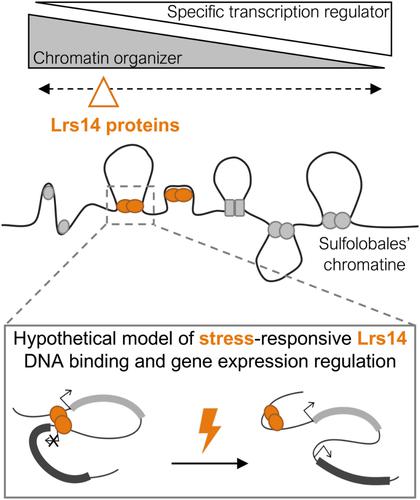当前位置:
X-MOL 学术
›
Mol. Microbiol.
›
论文详情
Our official English website, www.x-mol.net, welcomes your feedback! (Note: you will need to create a separate account there.)
The Lrs14 family of DNA‐binding proteins as nucleoid‐associated proteins in the Crenarchaeal order Sulfolobales
Molecular Microbiology ( IF 3.6 ) Pub Date : 2024-04-03 , DOI: 10.1111/mmi.15260 Veerke De Kock 1 , Eveline Peeters 1 , Rani Baes 1
Molecular Microbiology ( IF 3.6 ) Pub Date : 2024-04-03 , DOI: 10.1111/mmi.15260 Veerke De Kock 1 , Eveline Peeters 1 , Rani Baes 1
Affiliation

|
Organization of archaeal chromatin combines bacterial, eukaryotic, and unique characteristics. Many archaeal lineages harbor a wide diversity of small and highly expressed nucleoid‐associated proteins, which are involved in DNA structuring. In Sulfolobales, representing model organisms within the Crenarchaeota, Sul7d, Cren7, Sul10a, and Sul12a are well‐characterized nucleoid‐associated proteins. Here, we combine evidence that the Lrs14 family of DNA binders is part of the repertoire of nucleoid‐associated proteins in Sulfolobales. Lrs14‐encoding genes are widespread within genomes of different members of the Sulfolobales, typically encoded as four to nine homologs per genome. The Lrs14 proteins harbor a winged helix‐turn‐helix DNA‐binding domain and are typified by a coiled–coil dimerization. They are characterized by distinct sequence‐ and structure‐based features, including redox‐sensitive motifs and residues targeted for posttranslational modification, allowing a further classification of the family into five conserved clusters. Lrs14‐like proteins have unique DNA‐organizing properties. By binding to the DNA nonsequence specifically and in a highly cooperative manner, with a slight preference for AT‐rich promoter regions, they introduce DNA kinks and are able to affect transcription of adjacent transcription units either positively or negatively. Genes encoding Lrs14‐type proteins display considerable differential expression themselves in response to various stress conditions, with certain homologs being specific to a particular stressor. Taken together, we postulate that members of the Lrs14 family can be considered nucleoid‐associated proteins in Sulfolobales, combining a DNA‐structuring role with a global gene expression role in response to stress conditions.
中文翻译:

DNA 结合蛋白的 Lrs14 家族作为硫化叶菌目的类核相关蛋白
古细菌染色质的组织结合了细菌、真核和独特的特征。许多古细菌谱系都含有多种小且高表达的核相关蛋白,这些蛋白参与 DNA 结构。在硫化叶菌目中,Sul7d、Cren7、Sul10a 和 Sul12a 是典型的 Crenarchaeota 内的模式生物,是已充分表征的核相关蛋白。在这里,我们结合了证据,证明 Lrs14 DNA 结合物家族是硫化叶菌目中核仁相关蛋白库的一部分。 Lrs14 编码基因广泛存在于硫化叶菌目不同成员的基因组中,通常每个基因组编码为 4 到 9 个同源物。 Lrs14 蛋白具有翼状螺旋-转角-螺旋 DNA 结合结构域,并以卷曲螺旋二聚化为典型。它们具有基于不同序列和结构的特征,包括氧化还原敏感基序和针对翻译后修饰的残基,从而可以将该家族进一步分类为五个保守簇。 Lrs14 样蛋白具有独特的 DNA 组织特性。通过以高度合作的方式特异性结合 DNA 非序列,并稍微偏爱富含 AT 的启动子区域,它们引入 DNA 扭结,并能够对相邻转录单元的转录产生正向或负向影响。编码 Lrs14 型蛋白的基因在响应各种应激条件时表现出相当大的差异表达,某些同源物针对特定的应激源。综上所述,我们假设 Lrs14 家族的成员可以被认为是硫化叶菌目中的核相关蛋白,结合了 DNA 结构作用和响应应激条件的全局基因表达作用。
更新日期:2024-04-03
中文翻译:

DNA 结合蛋白的 Lrs14 家族作为硫化叶菌目的类核相关蛋白
古细菌染色质的组织结合了细菌、真核和独特的特征。许多古细菌谱系都含有多种小且高表达的核相关蛋白,这些蛋白参与 DNA 结构。在硫化叶菌目中,Sul7d、Cren7、Sul10a 和 Sul12a 是典型的 Crenarchaeota 内的模式生物,是已充分表征的核相关蛋白。在这里,我们结合了证据,证明 Lrs14 DNA 结合物家族是硫化叶菌目中核仁相关蛋白库的一部分。 Lrs14 编码基因广泛存在于硫化叶菌目不同成员的基因组中,通常每个基因组编码为 4 到 9 个同源物。 Lrs14 蛋白具有翼状螺旋-转角-螺旋 DNA 结合结构域,并以卷曲螺旋二聚化为典型。它们具有基于不同序列和结构的特征,包括氧化还原敏感基序和针对翻译后修饰的残基,从而可以将该家族进一步分类为五个保守簇。 Lrs14 样蛋白具有独特的 DNA 组织特性。通过以高度合作的方式特异性结合 DNA 非序列,并稍微偏爱富含 AT 的启动子区域,它们引入 DNA 扭结,并能够对相邻转录单元的转录产生正向或负向影响。编码 Lrs14 型蛋白的基因在响应各种应激条件时表现出相当大的差异表达,某些同源物针对特定的应激源。综上所述,我们假设 Lrs14 家族的成员可以被认为是硫化叶菌目中的核相关蛋白,结合了 DNA 结构作用和响应应激条件的全局基因表达作用。



























 京公网安备 11010802027423号
京公网安备 11010802027423号